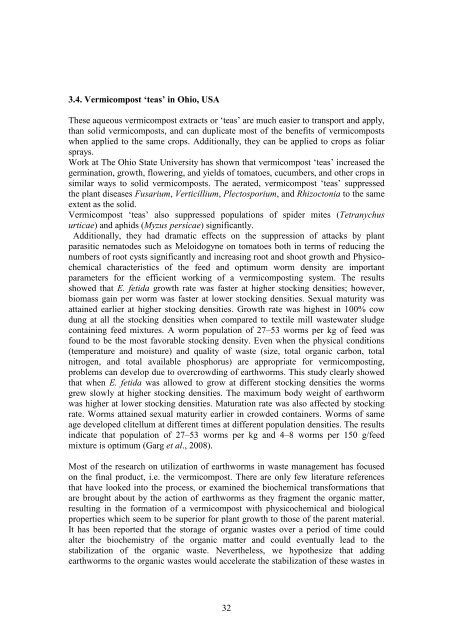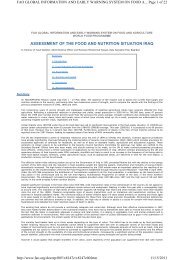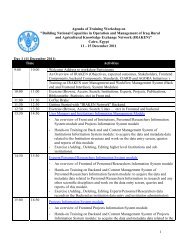Vermiculture in Egypt: - FAO - Regional Office for the Near East and
Vermiculture in Egypt: - FAO - Regional Office for the Near East and
Vermiculture in Egypt: - FAO - Regional Office for the Near East and
You also want an ePaper? Increase the reach of your titles
YUMPU automatically turns print PDFs into web optimized ePapers that Google loves.
3.4. Vermicompost „teas‟ <strong>in</strong> Ohio, USA<br />
These aqueous vermicompost extracts or „teas‟ are much easier to transport <strong>and</strong> apply,<br />
than solid vermicomposts, <strong>and</strong> can duplicate most of <strong>the</strong> benefits of vermicomposts<br />
when applied to <strong>the</strong> same crops. Additionally, <strong>the</strong>y can be applied to crops as foliar<br />
sprays.<br />
Work at The Ohio State University has shown that vermicompost „teas‟ <strong>in</strong>creased <strong>the</strong><br />
germ<strong>in</strong>ation, growth, flower<strong>in</strong>g, <strong>and</strong> yields of tomatoes, cucumbers, <strong>and</strong> o<strong>the</strong>r crops <strong>in</strong><br />
similar ways to solid vermicomposts. The aerated, vermicompost „teas‟ suppressed<br />
<strong>the</strong> plant diseases Fusarium, Verticillium, Plectosporium, <strong>and</strong> Rhizoctonia to <strong>the</strong> same<br />
extent as <strong>the</strong> solid.<br />
Vermicompost „teas‟ also suppressed populations of spider mites (Tetranychus<br />
urticae) <strong>and</strong> aphids (Myzus persicae) significantly.<br />
Additionally, <strong>the</strong>y had dramatic effects on <strong>the</strong> suppression of attacks by plant<br />
parasitic nematodes such as Meloidogyne on tomatoes both <strong>in</strong> terms of reduc<strong>in</strong>g <strong>the</strong><br />
numbers of root cysts significantly <strong>and</strong> <strong>in</strong>creas<strong>in</strong>g root <strong>and</strong> shoot growth <strong>and</strong> Physicochemical<br />
characteristics of <strong>the</strong> feed <strong>and</strong> optimum worm density are important<br />
parameters <strong>for</strong> <strong>the</strong> efficient work<strong>in</strong>g of a vermicompost<strong>in</strong>g system. The results<br />
showed that E. fetida growth rate was faster at higher stock<strong>in</strong>g densities; however,<br />
biomass ga<strong>in</strong> per worm was faster at lower stock<strong>in</strong>g densities. Sexual maturity was<br />
atta<strong>in</strong>ed earlier at higher stock<strong>in</strong>g densities. Growth rate was highest <strong>in</strong> 100% cow<br />
dung at all <strong>the</strong> stock<strong>in</strong>g densities when compared to textile mill wastewater sludge<br />
conta<strong>in</strong><strong>in</strong>g feed mixtures. A worm population of 27–53 worms per kg of feed was<br />
found to be <strong>the</strong> most favorable stock<strong>in</strong>g density. Even when <strong>the</strong> physical conditions<br />
(temperature <strong>and</strong> moisture) <strong>and</strong> quality of waste (size, total organic carbon, total<br />
nitrogen, <strong>and</strong> total available phosphorus) are appropriate <strong>for</strong> vermicompost<strong>in</strong>g,<br />
problems can develop due to overcrowd<strong>in</strong>g of earthworms. This study clearly showed<br />
that when E. fetida was allowed to grow at different stock<strong>in</strong>g densities <strong>the</strong> worms<br />
grew slowly at higher stock<strong>in</strong>g densities. The maximum body weight of earthworm<br />
was higher at lower stock<strong>in</strong>g densities. Maturation rate was also affected by stock<strong>in</strong>g<br />
rate. Worms atta<strong>in</strong>ed sexual maturity earlier <strong>in</strong> crowded conta<strong>in</strong>ers. Worms of same<br />
age developed clitellum at different times at different population densities. The results<br />
<strong>in</strong>dicate that population of 27–53 worms per kg <strong>and</strong> 4–8 worms per 150 g/feed<br />
mixture is optimum (Garg et al., 2008).<br />
Most of <strong>the</strong> research on utilization of earthworms <strong>in</strong> waste management has focused<br />
on <strong>the</strong> f<strong>in</strong>al product, i.e. <strong>the</strong> vermicompost. There are only few literature references<br />
that have looked <strong>in</strong>to <strong>the</strong> process, or exam<strong>in</strong>ed <strong>the</strong> biochemical trans<strong>for</strong>mations that<br />
are brought about by <strong>the</strong> action of earthworms as <strong>the</strong>y fragment <strong>the</strong> organic matter,<br />
result<strong>in</strong>g <strong>in</strong> <strong>the</strong> <strong>for</strong>mation of a vermicompost with physicochemical <strong>and</strong> biological<br />
properties which seem to be superior <strong>for</strong> plant growth to those of <strong>the</strong> parent material.<br />
It has been reported that <strong>the</strong> storage of organic wastes over a period of time could<br />
alter <strong>the</strong> biochemistry of <strong>the</strong> organic matter <strong>and</strong> could eventually lead to <strong>the</strong><br />
stabilization of <strong>the</strong> organic waste. Never<strong>the</strong>less, we hypo<strong>the</strong>size that add<strong>in</strong>g<br />
earthworms to <strong>the</strong> organic wastes would accelerate <strong>the</strong> stabilization of <strong>the</strong>se wastes <strong>in</strong><br />
32





